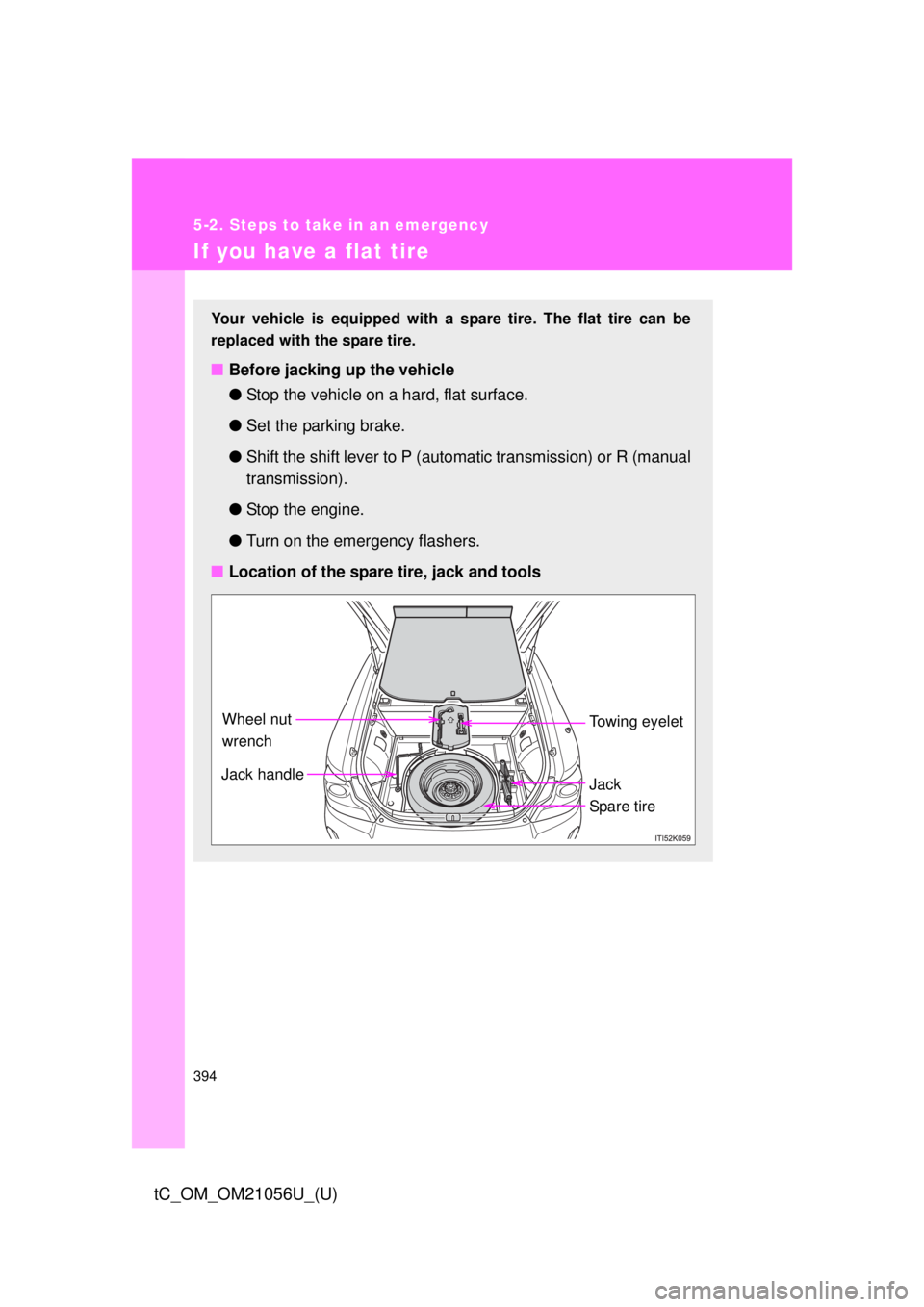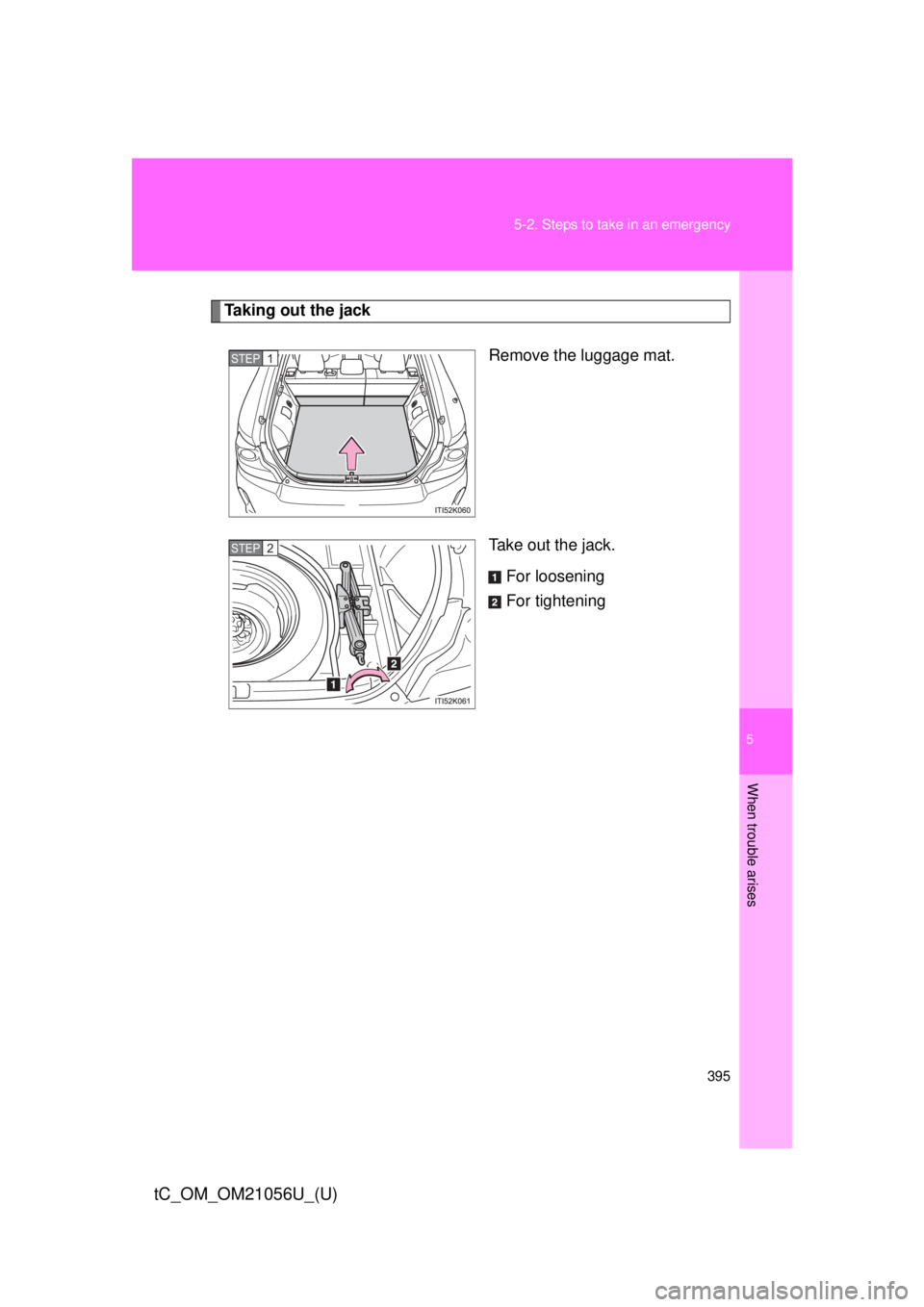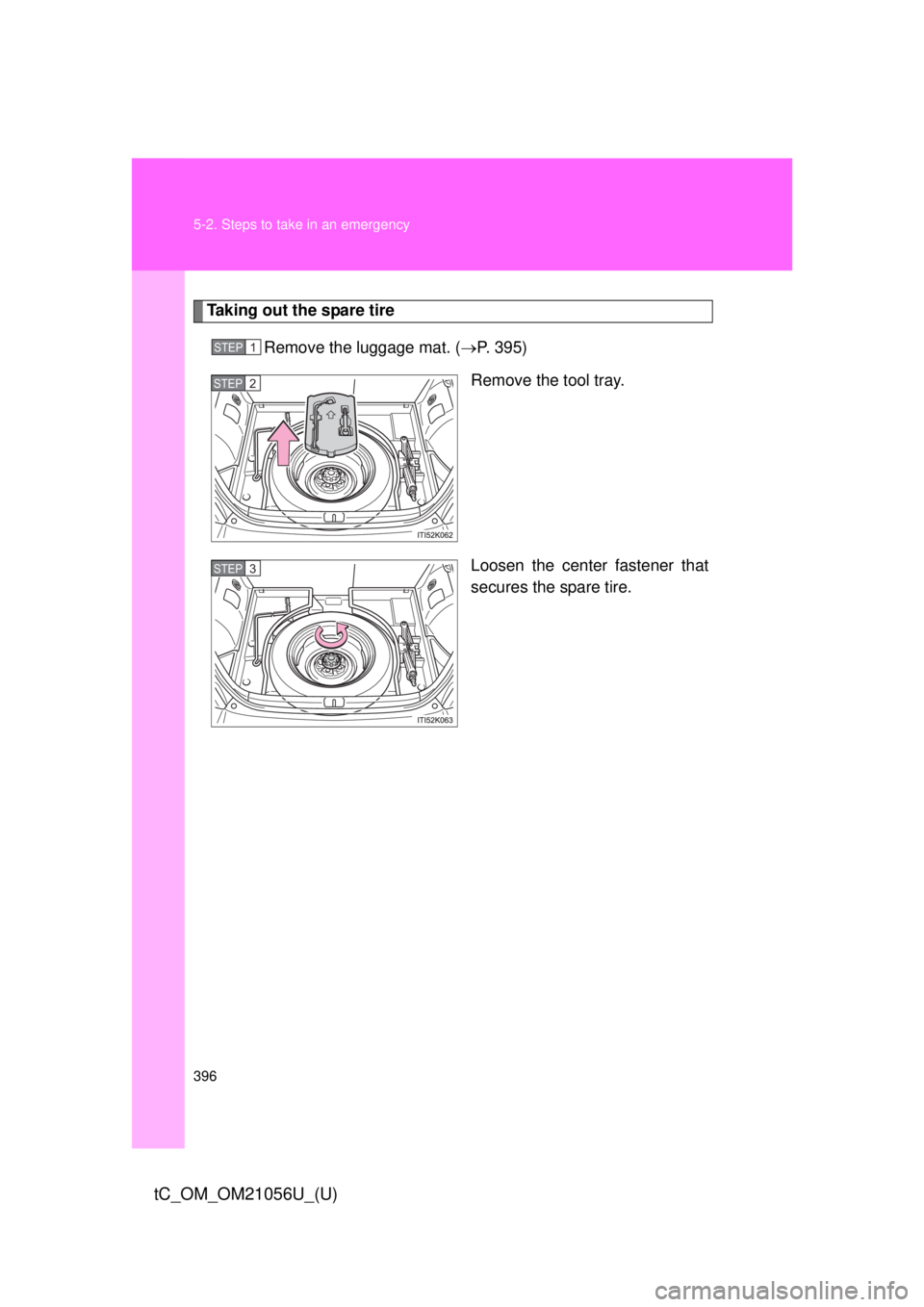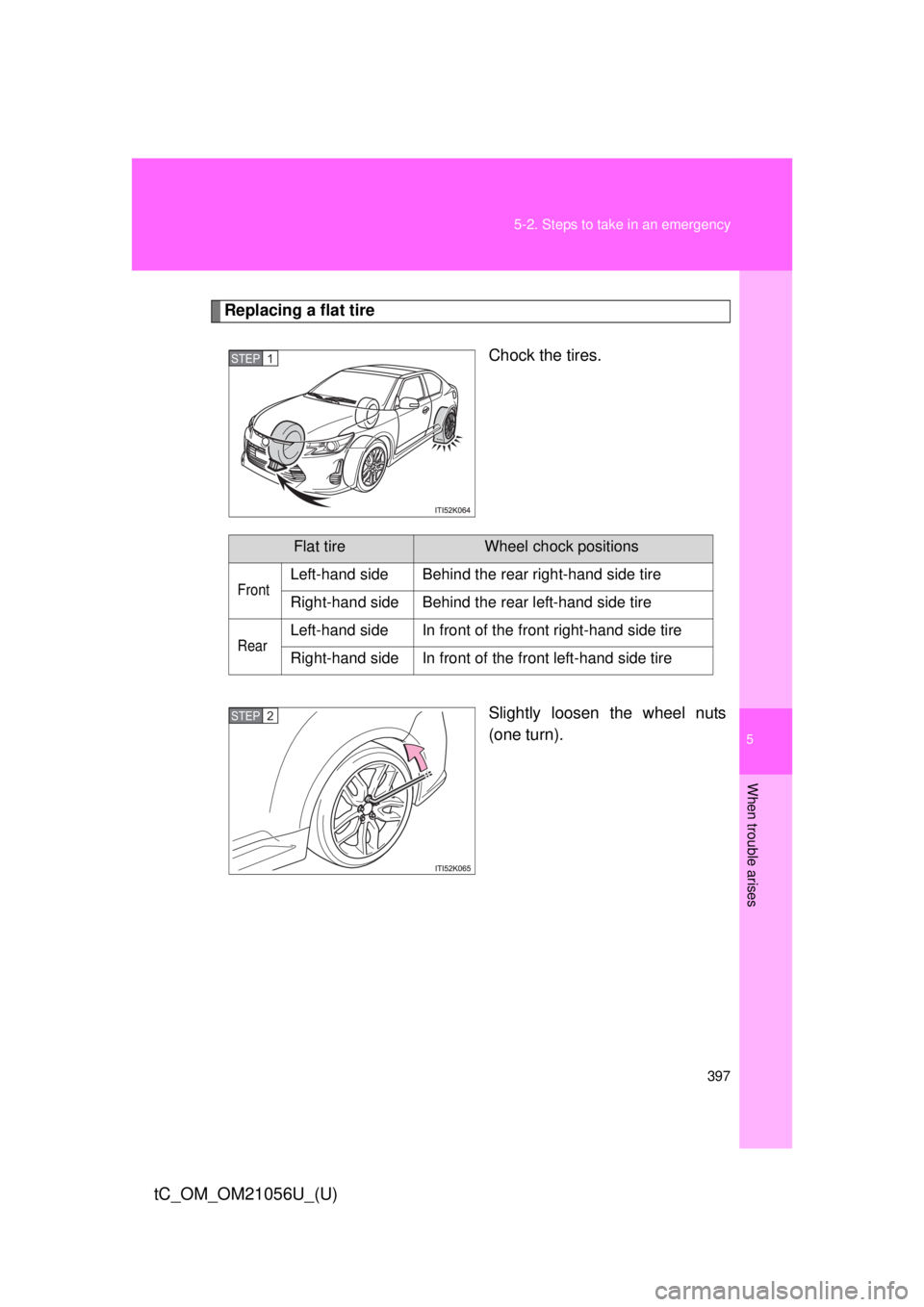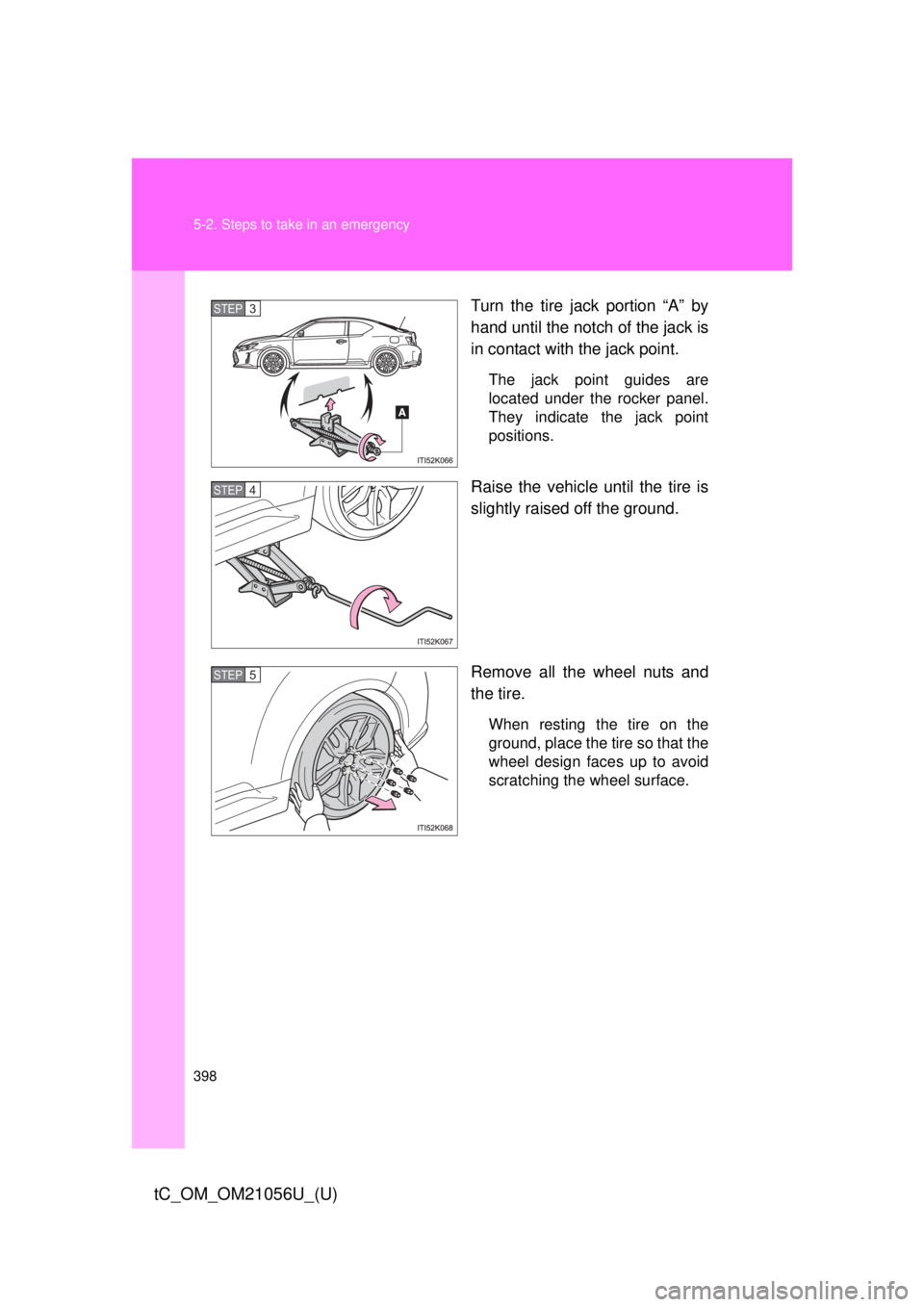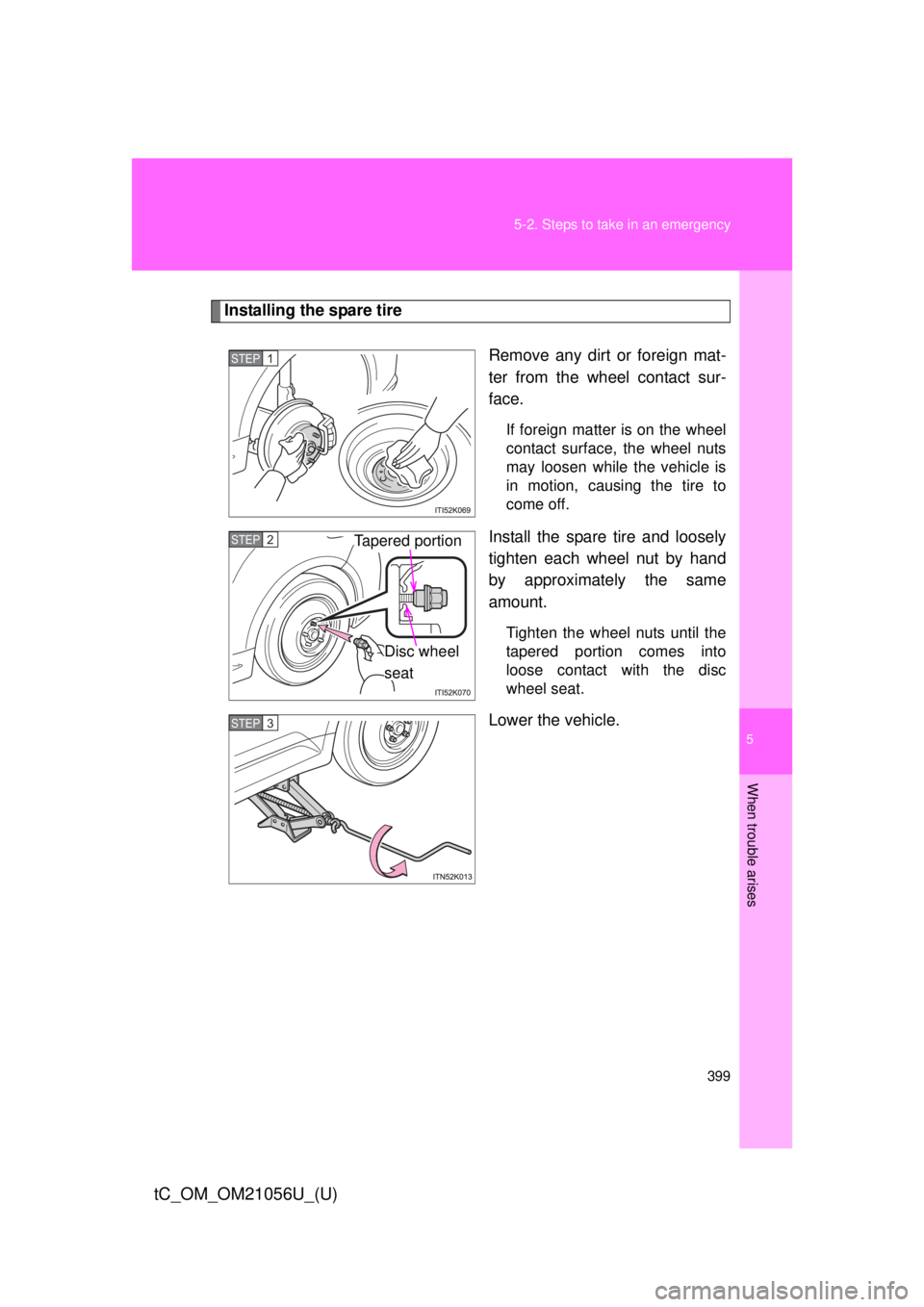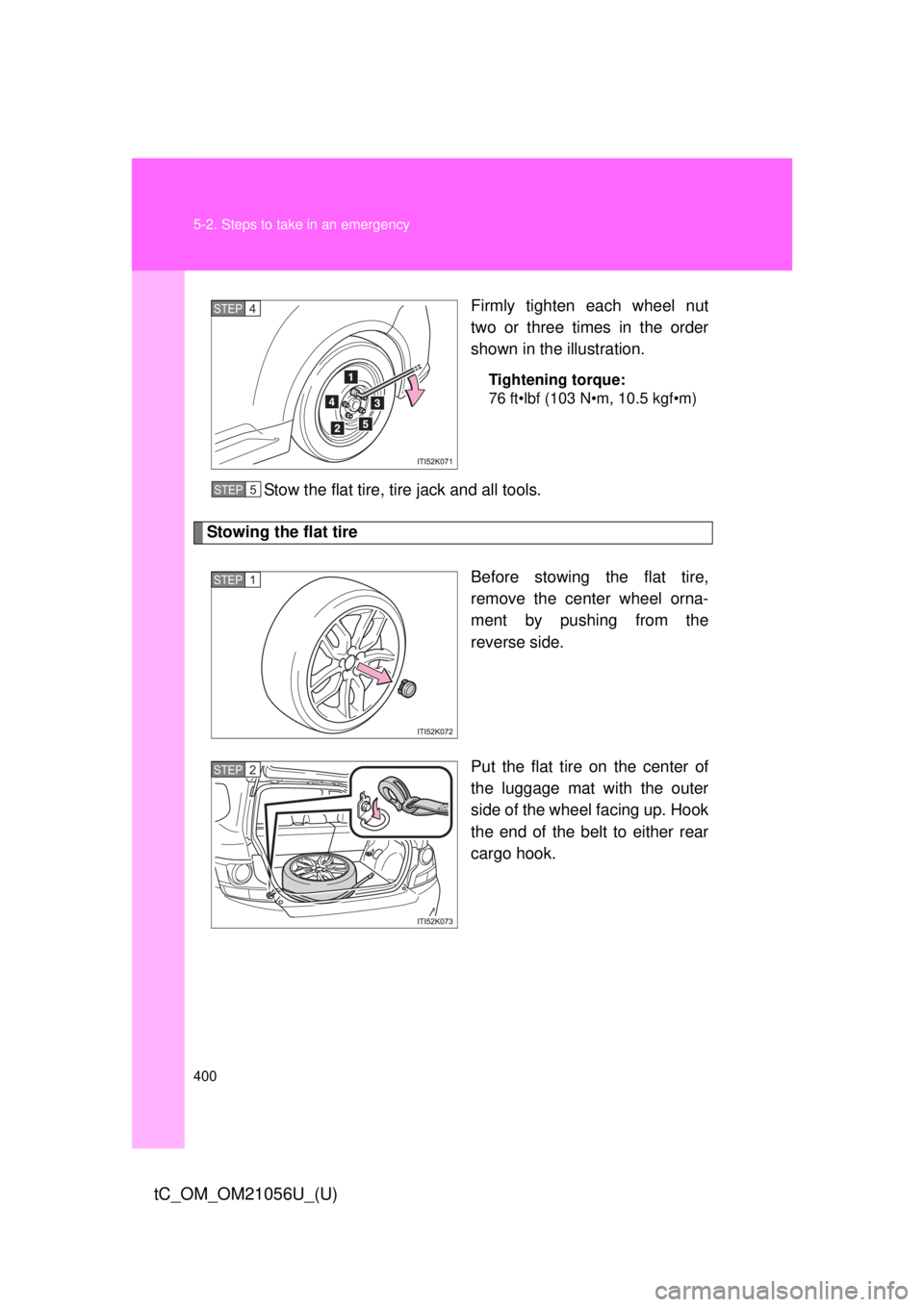TOYOTA tC 2016 Owners Manual (in English)
Manufacturer: TOYOTA, Model Year: 2016,
Model line: tC,
Model: TOYOTA tC 2016
Pages: 492, PDF Size: 9.44 MB
TOYOTA tC 2016 Owners Manual (in English)
tC 2016
TOYOTA
TOYOTA
https://www.carmanualsonline.info/img/14/43304/w960_43304-0.png
TOYOTA tC 2016 Owners Manual (in English)
Trending: park assist, coolant temperature, keyless entry, dashboard, flat tire, four wheel drive, heater
Page 391 of 492

5
When trouble arises
391
5-2. Steps to take in an emergency
tC_OM_OM21056U_(U)
CAUTION
■
When the electric power steerin g system warning light comes on
The steering wheel may become extremely heavy.
If the steering wheel becomes heavier than usual when operating, hold
firmly and operate using more force than usual.
■
If the tire pressure warning light comes on (U.S.A. only)
Be sure to observe the following precautions. Failure to do so could
cause a loss of vehicle control and result in death or serious injury.
●Stop your vehicle in a safe place as soon as possible. Adjust the tire
inflation pressure immediately.
●If the tire pressure warning light comes on even after tire inflation pres-
sure adjustment, it is pr obable that you have a flat tire. Check the tires.
If a tire is flat, change it with th e spare tire and have the flat tire
repaired by the nearest Scion dealer.
●Avoid abrupt maneuvering and braking. If the vehicle tires deteriorate,
you could lose control of the steering wheel or the brakes.
■If a blowout or sudden air leakage should occur (U.S.A. only)
The tire pressure warning syste m may not activate immediately.
Page 392 of 492

392 5-2. Steps to take in an emergency
tC_OM_OM21056U_(U)
CAUTION
■Maintenance of the tires (U.S.A. only)
Each tire, including the spare (if provided), should be checked monthly
when cold and inflated to the inflation pressure recommended by the
vehicle manufacturer on the vehicle placard or tire inflation pressure
label (tire and load information label). (If your vehicle has tires of a differ-
ent size than the size indicated on the vehicle placard or tire inflation
pressure label [tire and load information label], you should determine the
proper tire inflation pr essure for those tires.)
As an added safety feature, your vehicle has been equipped with a tire
pressure monitoring system (TPMS-ti re pressure warning system) that
illuminates a low tire pressure telltal e (tire pressure warning light) when
one or more of your tires is significantly under-inflated. Accordingly,
when the low tire pressu re telltale (tire pressure warning light) illumi-
nates, you should stop and check your tires as soon as possible, and
inflate them to the proper pressure. Driving on a significantly under-
inflated tire causes the tire to overheat and can lead to tire failure.
Under-inflation also reduces fuel effi ciency and tire tread life, and may
affect the vehicle’s handling and stopping ability.
Please note that the TPMS (tire pressure warning system) is not a sub-
stitute for proper tire main tenance, and it is the driver’s responsibility to
maintain correct tire pressure, even if under-inflation has not reached the
level to trigger illu mination of the TPMS low tire pressure telltale (tire
pressure warning light).
Page 393 of 492

5
When trouble arises
393
5-2. Steps to take in an emergency
tC_OM_OM21056U_(U)
CAUTION
Your vehicle has also been equipped with a TPMS (tire pressure warning
system) malfunction indicator to indi
cate when the system is not operat-
ing properly. The TPMS (tire pressure warning system) malfunction indi-
cator is combined with the low tire pressure telltale (tire pressure
warning light). When the system det ects a malfunction, the telltale will
flash for approximately one minute an d then remain continuously illumi-
nated. This sequence will continue upon subsequent vehicle start-ups as
long as the malfunction exists. When the malfunction indi cator is illumi-
nated, the system may not be able to detect or signal low tire pressure
as intended.
TPMS (tire pressure warning system) malfunctions may occur for a vari-
ety of reasons, including the installati on of replacement or alternate tires
or wheels on the vehicle that prevent the TPMS (tire pressure warning
system) from functioning properly. Always check the TPMS (tire pres-
sure warning system) malfunction te lltale after replacing one or more
tires or wheels on your vehicle to ensure that the replacement or alter-
nate tires and wheels allow the TPMS (tire pressure warning system) to
continue to function properly.
NOTICE
■To ensure the tire pressure warning system operates properly
(U.S.A. only)
Do not install tires with different s pecifications or makers, as the tire
pressure warning system may not operate properly.
Page 394 of 492
394
5-2. Steps to take in an emergency
tC_OM_OM21056U_(U)
If you have a flat tire
Your vehicle is equipped with a spare tire. The flat tire can be
replaced with the spare tire.
■Before jacking up the vehicle
●Stop the vehicle on a hard, flat surface.
● Set the parking brake.
● Shift the shift lever to P (automatic transmission) or R (manual
transmission).
● Stop the engine.
● Turn on the emergency flashers.
■ Location of the spare tire, jack and tools
Jack handle
Jack
Wheel nut
wrench
Spa r e tire
Towing eyelet
Page 395 of 492
5
When trouble arises
395
5-2. Steps to take in an emergency
tC_OM_OM21056U_(U)
Taking out the jack
Remove the luggage mat.
Take out the jack.For loosening
For tightening
STEP 1
STEP 2
Page 396 of 492
396 5-2. Steps to take in an emergency
tC_OM_OM21056U_(U)
Taking out the spare tireRemove the luggage mat. ( P. 395)
Remove the tool tray.
Loosen the center fastener that
secures the spare tire.
STEP 1
STEP 2
STEP 3
Page 397 of 492
5
When trouble arises
397
5-2. Steps to take in an emergency
tC_OM_OM21056U_(U)
Replacing a flat tire
Chock the tires.
Slightly loosen the wheel nuts
(one turn).
STEP 1
Flat tireWheel chock positions
FrontLeft-hand side Behind the rear right-hand side tire
Right-hand side Behind the rear left-hand side tire
RearLeft-hand side In front of the front right-hand side tire
Right-hand side In front of the front left-hand side tire
STEP 2
Page 398 of 492
398 5-2. Steps to take in an emergency
tC_OM_OM21056U_(U)
Turn the tire jack portion “A” by
hand until the notch of the jack is
in contact with the jack point.
The jack point guides are
located under the rocker panel.
They indicate the jack point
positions.
Raise the vehicle until the tire is
slightly raised off the ground.
Remove all the wheel nuts and
the tire.
When resting the tire on the
ground, place the tire so that the
wheel design faces up to avoid
scratching the wheel surface.
STEP 3
STEP 4
STEP 5
Page 399 of 492
5
When trouble arises
399
5-2. Steps to take in an emergency
tC_OM_OM21056U_(U)
Installing the spare tire
Remove any dirt or foreign mat-
ter from the wheel contact sur-
face.
If foreign matter is on the wheel
contact surface, the wheel nuts
may loosen while the vehicle is
in motion, causing the tire to
come off.
Install the spare tire and loosely
tighten each wheel nut by hand
by approximately the same
amount.
Tighten the wheel nuts until the
tapered portion comes into
loose contact with the disc
wheel seat.
Lower the vehicle.
STEP 1
STEP 2 Tapered portion
Disc wheel
seat
STEP 3
Page 400 of 492
400 5-2. Steps to take in an emergency
tC_OM_OM21056U_(U)
Firmly tighten each wheel nut
two or three times in the order
shown in the illustration.
Tightening torque:
76 ft•lbf (103 N•m, 10.5 kgf•m)
Stow the flat tire, tire jack and all tools.
Stowing the flat tire
Before stowing the flat tire,
remove the center wheel orna-
ment by pushing from the
reverse side.
Put the flat tire on the center of
the luggage mat with the outer
side of the wheel facing up. Hook
the end of the belt to either rear
cargo hook.
STEP 4
STEP 5
STEP 1
STEP 2
Trending: immobilizer, maintenance schedule, change wheel, belt, overheating, set clock, keyless



